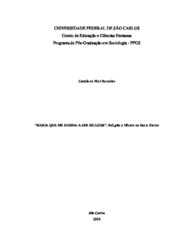Mostrar el registro sencillo del ítem
"Maria que me ensina a ser mulher": religião e gênero no Santo Daime
| dc.contributor.author | Benedito, Camila de Pieri | |
| dc.date.accessioned | 2019-05-08T17:37:13Z | |
| dc.date.available | 2019-05-08T17:37:13Z | |
| dc.date.issued | 2019-04-03 | |
| dc.identifier.citation | BENEDITO, Camila de Pieri. "Maria que me ensina a ser mulher": religião e gênero no Santo Daime. 2019. Tese (Doutorado em Sociologia) – Universidade Federal de São Carlos, São Carlos, 2019. Disponível em: https://repositorio.ufscar.br/handle/ufscar/11390. | * |
| dc.identifier.uri | https://repositorio.ufscar.br/handle/ufscar/11390 | |
| dc.description.abstract | This thesis is the result of the ethnography performed in the Céu do Gamarra, a religious community of Santo Daime located in the city of Baependi, in south Minas Gerais. Seeking to interpret how gender discourse develops in the community, the research explored how the "feminine" and "masculine" categories are constructed and then observed that they are conceived like essences, in opposition and complementarity, definiyng religious and daily practices of affiliates and affiliated. The construction of this discourse is related to the religious matrices that underpinned the formation and development of the Santo Daime, as well as the historical context that surrounded it. Particular emphasis is placed on devotional centrality to the Virgin of the Conception, a centrality originated from her apparition to the founder Raimundo Irineu Serra. Mary is considered the quintessence of the feminine and, therefore, an archetype to be followed by earthly women, then protagonists of the domestic universe, of sacred and natural motherhood, and the ideals of care and suffering. The thesis also observes how from this polarity also emerges a conception of sacred marriage between the "feminine" and "masculine" forces, which punctuates a heteronormative discourse that values the heterosexual, nuclear, and reproductive family. The research was developed theoretically-methodologically based on the intersection between religion and gender, covered the bibliography on the ayahuasca field, ethnographic immersion, the study of Santo Daime’s liturgical material, semi-structured interviews with leaders and affiliates of the religious community and formulation of content for the community’s website. | eng |
| dc.description.sponsorship | Coordenação de Aperfeiçoamento de Pessoal de Nível Superior (CAPES) | por |
| dc.language.iso | por | por |
| dc.publisher | Universidade Federal de São Carlos | por |
| dc.rights.uri | Acesso aberto | por |
| dc.subject | Santo Daime | por |
| dc.subject | Religiões Ayahuasqueiras | por |
| dc.subject | Gênero | por |
| dc.subject | Ayahuasca religions | eng |
| dc.subject | Gender | eng |
| dc.title | "Maria que me ensina a ser mulher": religião e gênero no Santo Daime | por |
| dc.title.alternative | "Maria who teaches me how to be a woman": religion and gender within Santo Daime | eng |
| dc.type | Tese | por |
| dc.contributor.advisor1 | Souza, André Ricardo de | |
| dc.contributor.advisor1Lattes | http://lattes.cnpq.br/7016915324466152 | por |
| dc.description.resumo | Esta tese é resultado da etnografia feita no Céu do Gamarra, comunidade religiosa do Santo Daime localizada na cidade de Baependi, no sul do estado de Minas Gerais. Buscando interpretar como o discurso de gênero se desenvolve na comunidade, a pesquisa explorou como as categorias “feminino” e “masculino” são construídas êmicamente e observou que elas são concebidas enquanto essências, em oposição e complementariedade, e definem práticas religiosas e cotidianas de filiados e filiadas. A construção desse discurso se relaciona com as matrizes religiosas que sustentaram a formação e o desenvolvimento do Santo Daime, bem como do contexto histórico que o circundou. É dado especial destaque para a centralidade devocional à Virgem da Conceição, oriunda do fenômeno da aparição mariana ao fundador Raimundo Irineu Serra. Maria é considerada a quintessência do feminino e, portanto, arquétipo a ser seguido pelas mulheres terrenas, então protagonistas do universo doméstico, da maternidade sagrada e natural, dos ideais de cuidado e de sofrimento. Aos homens e à masculinidade, cabem os aspectos de provimento, força bruta e racionalidade. A tese também observa como dessa polaridade emerge uma concepção de casamento sagrado entre as forças “feminina” e “masculina”, que pontua um discurso heteronormativo que valoriza a família heterossexual, nuclear, reprodutiva. A pesquisa foi desenvolvida teórico-metodologicamente com base na intersecção entre religião e gênero, abrangeu a bibliografia sobre o campo ayahuasqueiro, imersão etnográfica, o estudo do material litúrgico daimista, entrevistas semiestruturadas em profundidade com líderes e filiadas da comunidade religiosa e formulação de conteúdo para sítio virtual da comunidade. | por |
| dc.publisher.initials | UFSCar | por |
| dc.publisher.program | Programa de Pós-Graduação em Sociologia - PPGS | por |
| dc.subject.cnpq | CIENCIAS HUMANAS::SOCIOLOGIA::OUTRAS SOCIOLOGIAS ESPECIFICAS | por |
| dc.description.sponsorshipId | CAPES: 88882.330899/2015-01 | por |
| dc.ufscar.embargo | Online | por |
| dc.publisher.address | Câmpus São Carlos | por |
| dc.contributor.authorlattes | http://lattes.cnpq.br/6114351330180363 | por |
